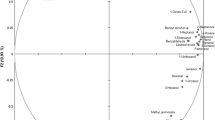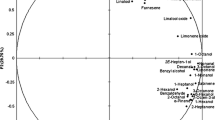Abstract
Aulacophora foveicollis Lucas (Coleoptera: Chrysomelidae) and Epilachna dodecastigma (Wied.) (Coleoptera: Coccinellidae) are important herbivore pests of Momordica cochinchinensis Spreng (Cucurbitaceae).The volatile organic compound (VOC) profile from undamaged and mechanically damaged plants, and from plants 24 h and 120 h following continuous feeding of adult female A. foveicollis and E. dodecastigma, was identified and quantified by GC-MS and GC-FID analyses. Twenty-two compounds were identified in volatiles of undamaged plants and in 24-h and 120-h post-insect-feeding plant volatiles; whereas 21 components were detected in volatiles of mechanically damaged plants. With the exception of four compounds, 1-heptanol, 3-octanone, acetophenone and nerolidol, the emissions of all other compounds were significantly increased following insect attack. In all plants, phytol was predominant, followed by geranyl linalool and linalool. Only 2-hexanol was unique to mechanically damaged plants, and 1-octen-3-ol and farnesyl acetone were detected in volatiles of undamaged and insect-damaged plants, but not in volatiles of mechanically damaged plants. However, none of these volatile components, when tested individually, showed attraction to A. foveicollis in Y-shaped glass tube olfactometer bioassays. Aulacophora foveicollis elicited significant preference for the whole volatile blends from insect-damaged plants compared to those of undamaged plants, and volatiles from 120-h post-E. dodecastigma feeding plants were more attractive to A. foveicollis compared to those from conspecifically damaged plants. Furthermore, the finding that A. foveicollis responds to individual synthetic compounds, 1-heptanol, 3-octanol, linalool oxide, 1-octanol, nonanal, geranyl linalool and phytol, and provide a basis for new inventions on trapping tools for pest management strategies.

Similar content being viewed by others
References
Binder RG, Flath RA, Mon TR (1989) Volatile components of bitter melon. J Agric Food Chem 37:418–420
Bolter CJ, Dicke M, Van Loon JJA, Visser JH, Posthumus MA (1997) Attraction of Colorado potato beetle to herbivore-damaged plants during herbivory and after its termination. J Chem Ecol 23:1003–1023
Bruce TJA, Pickett JA (2011) Perception of plant volatile blends by herbivorous insects − finding the right mix. Phytochemistry 72:1605–1611
Bruce TJA, Wadhams LJ, Woodcock CM (2005) Insect host location: a volatile situation. Trends Plant Sci 10:269–274
Burke DS, Smidt CR, Vuong LT (2005) Momordica cochinchinensis, Rosa roxburghii, Wolfberry, and Sea buckthorn–highly nutritional fruits supported by tradition and science. Curr Top Nutraceut R 3:259–266
Choudhuri DK, Mondal S, Ghosh B (1983) Insect pest and host plant interaction: the influence of host plant on the bionomics of Epilachna dodecastigma (Coleoptera: Coccinellidae). Com Physiol Ecol 8:150–154
Crosskey RW (1973) A conspectus of the Tachinidae (Diptera) of Australia, including keys to the supraspecific taxa and taxonomic and host catalogues. Bull Br Mus Entomol Suppl (Natural History) 21:1–221
De Moraes CM, Lewis WJ, Paré PW, Alborn HT, Tumlinson JH (1998) Herbivore infested plants selectively attract parasitiods. Nature 393:570–573
Dugravot S, Brunissen L, Létocart E, Tjallingii WF, Vincent C, Giordanengo P, Cherqui A (2007) Local and systemic responses induced by aphids in Solanum tuberosum plants. Entomol Exp Appl 123:271–277
Fernando LN, Grün IU (2001) Headspace-SPME analysis of volatiles of the ridge gourd (Luffa cylindrica) and bitter gourd (Momordica charantia) flowers. Flav Frag J 16:289–293
Hossain MS, Khan AB, Haque MA, Mannan MA, Dash CK (2009) Effect of different host plants on growth and development of epilachna beetle. Bangladesh J Agril Res 34:403–410
Khan MMH, Alam MZ, Rahaman MM (2011) Host preference of red pumpkin beetle in a choice test under net case condition. Bangladesh J Zool 39:231–234
Landolt PJ, Tumlinson JH, Alborn DH (1999) Attraction of Colorado potato beetle (Coleoptera: Chrysomelidae) to damaged and chemically induced potato plants. Environ Entomol 28:973–978
Lim TK (2012) Edible medicinal and non-medicinal plants: Volume 2 fruits. Springer, New York
Magalhães DM, Borges M, Laumann RA, Sujii ER, Mayon P, Caulfield JC, Midega CAO, Khan ZR, Pickett JA, Birkett MA, Blassioli-Moraes MC (2012) Semiochemicals from herbivory induced cotton plants enhance the foraging behaviour of the cotton boll weevil, Anthonomus grandis. J Chem Ecol 38:1528–1538
Moronkola DO, Ogunwande IA, Oyewole IO, Baser KHC, Ozek T, Ozek G (2009) Studies on the volatile oils of Momordica charantia L. (Cucurbitaceae) and Phyllanthus amarus Sch. et Thonn (Euphorbiaceae). J Essen Oil Res 21:393–399
Mukherjee A, Barik A (2014) Long-chain free fatty acids from Momordica cochinchinensis Spreng flowers as allelochemical influencing the attraction of Aulacophora foveicollis Lucas (Coleoptera: Chrysomelidae). Allelopathy J 33:255–266
Mukherjee A, Sarkar N, Barik A (2013) Alkanes in flower surface waxes of Momordica cochinchinensis influence attraction to Aulacophora foveicollis Lucas (Coleoptera: Chrysomelidae). Neotrop Entomol 42:366–371
Mukherjee A, Sarkar N, Barik A (2014) Long-chain free fatty acids from Momordica cochinchinensis leaves as attractants to its insect pest, Aulacophora foveicollis Lucas (Coleoptera: Chrysomelidae). J Asia-Pacific Entomol 17:229–234
Pallini A, Janssen A, Sabelis MW (1997) Odour-mediated responses of phytophagous mites to conspecific and heterospecific competitors. Oecologia 110:179–185
Paré PW, Tumlinson JH (1996) Plant volatile signals in response to herbivore feeding. Florida Entomol 79:93–103
Paré PW, Tumlinson JH (1999) Plant volatiles as a defense against herbivores. Plant Physiol 121:325–331
Piesik D, Pańka D, Delaney KJ, Skoczek A, Lamparski R, Weaver DK (2011) Cereal crop volatile organic compound induction after mechanical injury, beetle herbivory (Oulema spp.), or fungal infection (Fusarium spp.). J Plant Physiol 168:878–886
Piesik D, Delaney KJ, Wenda-Piesik A, Sendel S, Tabaka P, Buszewski B (2013) Meligethes aeneus pollen-feeding suppresses, and oviposition induces, Brassica napus volatiles: beetle attraction/repellence to lilac aldehydes and veratrole. Chemoecology 23:241–250
Rahaman MA, Prodhan MDH (2007) Effects of net barrier and synthetic pesticides on Red pumpkin beetle and yield of cucumber. Int J Sustain Crop Prod 2:30–34
Raman K, Annadurai RS (1985) Host selection and food utilization of the red pumpkin beetle, Raphidopalpa foveicollis (Lucas) (Coleoptera: Chrysomelidae). Proc Ind Acad Sci (Anim Sci) 94:547–556
Riffell JA, Lie H, Christensen TA, Hilderbrand JG (2009) Characterization and coding of behaviourally significant odor mixtures. Curr Biol 19:335–340
Röse URS, Manukian A, Heath RR, Tumlinson JH (1996) Volatile semiochemicals released from undamaged cotton leaves (a systemic response of living plants to caterpillar damage). Plant Physiol 111:487–495
Roy N, Laskar S, Barik A (2012) The attractiveness of odorous esterified fatty acids to the potential biocontrol agent, Altica cyanea. J Asia-Pacific Entomol 15:277–282
Sarkar N, Barik A (2014) Role of alkanes from bitter gourd flower surface waxes as allelochemicals in olfactory responses of Epilachna dodecastigma (Wied.) (Coleoptera: Coccinellidae). Allelopathy J 33:43–52
Sarkar N, Mukherjee A, Barik A (2013a) Long-chain alkanes: allelochemicals for host location by the insect pest, Epilachna dodecastigma (Coleoptera: Coccinellidae). Appl Entomol Zool 48:171–179
Sarkar N, Mukherjee A, Barik A (2013b) Olfactory responses of Epilachna dodecastigma (Coleoptera: Coccinellidae) to long-chain fatty acids from Momordica charantia leaves. Arthropod-Plant Interact 7:339–348
Sarkar N, Mukherjee A, Barik A (2014) Attraction of Epilachna dodecastigma (Coleoptera: Coccinellidae) to Momordica charantia (Cucurbitaceae) leaf volatiles. Canad Entomol. doi:10.4039/tce.2014.37
Schoonhoven LM, Van Loon JJA, Dicke M (2005) Insect-Plant biology. Oxford University Press, Oxford
Singh D, Gill CK (1979) Estimation of losses in growth and yield of muskmelon due to Aulacophora foveicollis (Lucas). Ind J Entomol 44:294–295
Sinha SN, Chakrabarti AK (1983) Effect of seed treatment with carbofuran on the incidence of red pumpkin beetle, Rhaphidopalpa foveicollis (Lucas) on cucurbits. Ind J Entomol 45:145–151
Tabata J, DeMoraes CM, Mescher MC (2011) Olfactory cues from plants infected by powdery mildew guide foraging by a mycophagous ladybird beetle. PLoS One 6(8):e23799. doi:10.1371/journal.pone.0023799
Turlings TC, Tumlinson JH (1992) Systemic release of chemical signals by herbivore-injured corn. Proc Natl Acad Sci USA 89:8399–8402
Waterhouse DF, Norris KR (1987) Aulacophora Species in Biological Control Pacific Prospects. Inkata Press, Melbourne
Webster B, Bruce T, Pickett J, Hardie J (2010) Volatiles functioning as host cues in a blend become nonhost cues when presented alone to the black bean aphid. Anim Behav 79:451–457
Acknowledgments
We thank Dr. Kerstin Reifenrath and anonymous reviewer(s) for many helpful comments on earlier versions of the manuscript. We are thankful to Dr. Poorani Janakiraman, National Bureau of Agriculturally Important Insects (formerly PDBC), Karnataka, India for identifying insects. The financial assistance from the University Grants Commission (UGC), India as a Senior Research Fellowship to Abhishek Mukherjee, DST–PURSE and DRS SAP for providing necessary instrumental facilities are gratefully acknowledged.
Author information
Authors and Affiliations
Corresponding author
Additional information
Handling Editor: Kerstin Reifenrath.
Electronic supplementary material
Below is the link to the electronic supplementary material.
Rights and permissions
About this article
Cite this article
Mukherjee, A., Sarkar, N. & Barik, A. Momordica cochinchinensis (Cucurbitaceae) leaf volatiles: semiochemicals for host location by the insect pest, Aulacophora foveicollis (Coleoptera: Chrysomelidae). Chemoecology 25, 93–104 (2015). https://doi.org/10.1007/s00049-014-0179-9
Received:
Accepted:
Published:
Issue Date:
DOI: https://doi.org/10.1007/s00049-014-0179-9




